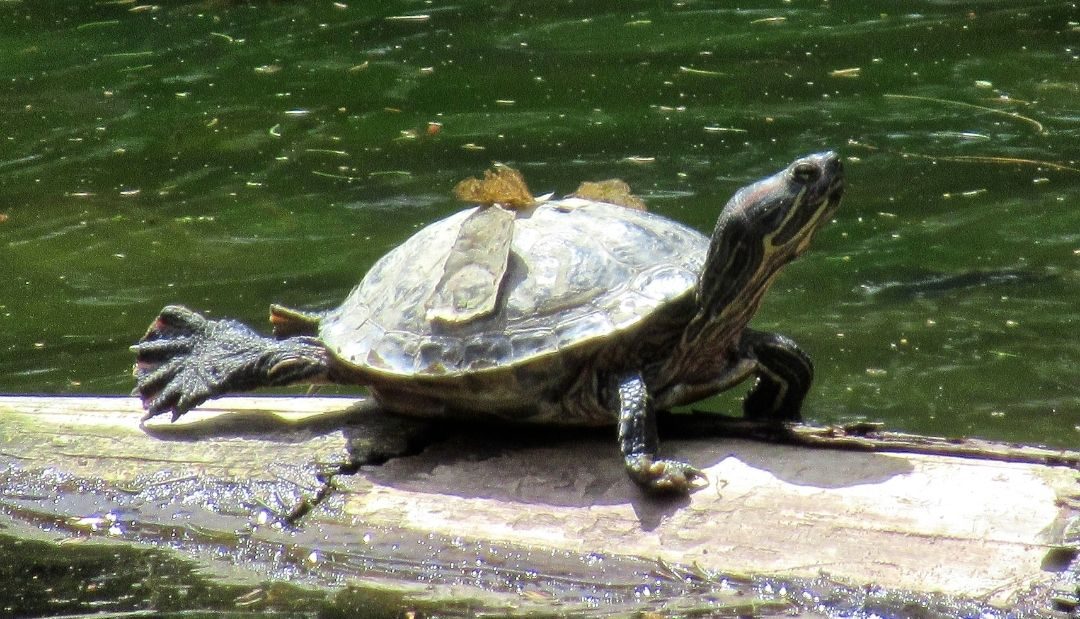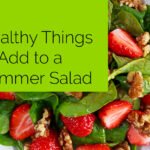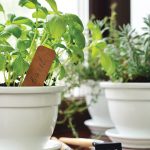Written by Pam Varga, Chairman of the I.S. and Gertrude Sahli Nature Park Advisory Committee
If you take a walk around the ponds at Sahli Nature Park in the late spring or during the summer, you may see turtles basking in the sun on logs floating in the water. Like all reptiles, turtles are “cold blooded.”
This doesn’t mean their blood is cold. Reptiles are ectothermic. The temperature of their bodies is close to the temperature of the air and water around them. Their bodies need an external source of heat like the sun to warm them up so that their bodies can function. That’s why you’ll see turtles stretched out in the sun warming themselves. When their bodies get warm enough, they dive back into the cool water. So, what do turtles do when the cold temperatures of winter come? How do they survive?
When the weather gets cold and food is scarce, mammals go into a kind of deep sleep called hibernation. Turtles undergo something similar called brumation. They bury themselves in the soft mud at the bottom of the pond or along the shore. Their heartbeat, breathing, metabolism, and other body processes slow down. Their hearts usually beat between 40 – 45 times a minute, but during brumation, their heartbeat slows to about 10 times a minute.
Turtles come to the surface to breathe through their nostrils and draw air into their lungs be-fore they dive underwater. They can stay under water for 20 – 30 minutes before coming up to take another breath. So, how can they breathe when they are under water all winter or when ice covers the water?
During brumation, water flows into the turtle’s body through an opening under the tail called the cloaca. Inside the cloaca are two sacs filled with blood vessels. As the water flows over them, the blood vessels absorb oxygen from the water. Turtles are “butt breathers” when they are in brumation. Since all of its body processes have slowed down, the turtle can live under water for months on stored food energy and the oxygen absorbed from the water. During brumation, you can sometimes see turtles moving slowly around under the ice.
When a turtle feels threatened, it pulls its body into its shell. The shell is made of two boney plates. The upper part of the shell is called the carapace, and the bottom part is called the plastron. The shell is part of the turtle’s skeleton. The backbones or vertebrae are part of the carapace. Flattened rib bones extending out from the vertebrae make up the rest of the carapace. Because the shell is part of its skeleton, a turtle cannot shed its shell. The turtle’s head, legs and tail are attached to the shell, and its body organs are inside. Some turtle shells have a hinged bottom so the turtle can completely seal itself inside. Flat horny plates called scutes cover the shell giving it color and pattern. Scutes are shed once a year and new ones grow. The color, pattern, and shape of the turtle’s shell can help us identify the species. Sometimes people like to carve their initials into a turtle’s shell, especially the shells of Box Turtles. Ouch! This is like carving into the animals bones! Please don’t do it!
The two kinds of turtles you may see at Sahli Park are the Painted Turtle and the Red Eared Slider. The Painted Turtle’s shell is black or olive green. The edge of the shell has red and black markings. This turtle’s skin is black with red and yellow markings. The shell of the Red Eared Slider is bright green with yellow markings. Its skin is green and yellow striped. In keeping with its name, the Red Eared Slider has a bright red patch behind each eye. Painted Turtles are native and can be found throughout North America. The Red Eared Slider is not native to Pennsylvania. For many years the Red Eared Slider has been a popular pet. Unfortunately, many pet owners released their turtles into the wild, and Red Eared Sliders can now be found in almost every pond and marsh and are considered to be very invasive.
Turtles are omnivorous. That means they eat both plants and other animals, living or dead. Young turtles eat mostly animals, while adults eat more plants. Turtles eat fish, tadpoles, crayfish, snails, aquatic insects, worms, algae, water lily leaves and seeds, duckweed and other aquatic plants. Turtles don’t have teeth. Instead, they have a hard sharp edge around their mouths called a beak.
They have webbed back feet for swimming and claws for digging. The male’s claws are longer than the female’s. During courtship, the male faces the female and gently pats her cheeks with his claws to entice her to mate. When it comes time to reproduce, the mama turtle uses her back feet to dig a hole in soft, well-drained soil near the pond. She lays four to 20 white oval shaped eggs with leathery flexible shells and then covers the nest with soil, leaving the eggs to hatch and the nestlings to survive on their own.
The next time you see a turtle at the park, can you tell if it’s a Painted Turtle or a Red Eared Slider?







